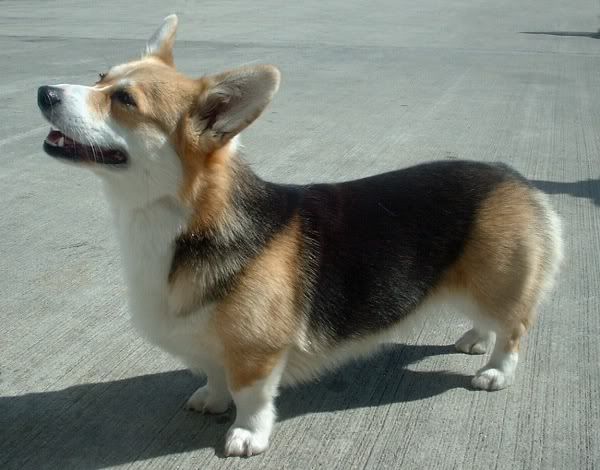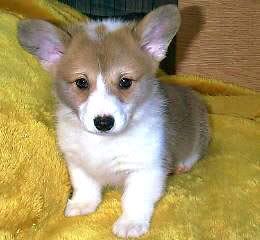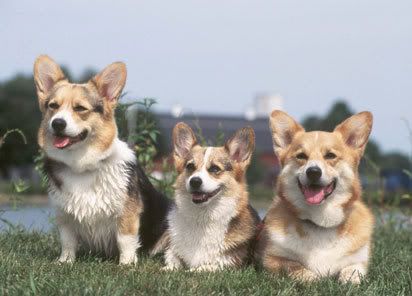Post by charmingnancy on Jan 6, 2009 12:45:26 GMT -5
Pembroke Welsh Corgi
Group: 7 - Herding Dogs
Origin: Pembrokeshire, Wales
Purpose: Herding sheep, horses and cattle.

Description:
Like most herding breeds, Pembrokes are active, intelligent and athletic dogs, despite their short legs and stocky body. The short legs may seem to be a disadvantage, but they can run and jump just as well as any other dog of comparable size. They were originally used to herd sheep, horses and cattle by nipping at their heels, and the short legs help kicks to pass safely over their heads.
Appearance- Breed Standards:
Coat and Colour: The outer coat is to be of self-colours in red, sable, fawn, black and tan, all with or without white markings on legs, chest, neck (either in part or as a collar), muzzle, underparts or as a narrow blaze on the head or foreface. The coat should be of medium length; short, thick, weather resistant undercoat with a coarser, longer outer coat, with slightly thicker and longer ruff around the neck, chest and underparts, and somewhat fuller and long on rear hindquarters. The coat should be straight. The Corgi should be shown in its natural condition with no trimming permitted except to tidy the feet.
Head: Foxy in appearance, but not snipey. Skull to be fairly wide and flat between the ears. Moderate amount of stop. Length of foreface to be in proportion to the skull as 3 is to 5. The line of the muzzle should be parallel to the line of skull when viewed from the side. There should be chiseling below the eyes with no fullness or cheekiness. Muzzle slightly tapered. Nose black and fully pigmented. Mouth scissor bite. Eyes well set, oval, medium in size. Dark brown in harmony with the coat colour. Eye rims dark, black preferred. Yellow, bluish or black eyes are most undesirable. Ears erect, firm, of medium size, tapering to a rounded point. A line drawn from the tip of the nose through the eye to the ear tips and across, should form an appropriate equilateral triangle.
Neck: Fairly long and of sufficient length to provide overall balance.
Forequarters: Shoulders blades long and well laid back along the rib cage. Upper arm nearly equal in length to shoulder blades, and moulded around chest. The distance between the wrists should be less than between the shoulder joints, so that the front does not appear absolutely straight. Elbows fitting closely to sides, neither loose nor tied. Lower arm - ample bone carried down into the feet, elbows parallel to the body, well set back to allow a line perpendicular to the ground to be drawn from the tip of the shoulder blade through the elbow. Legs short. Pasterns - firm and nearly straight when viewed from the side. Feet- Oval with two centre toes slightly in advance of the two outer ones. Toes strong, well arched and tight, pads strong and thick, nails short.
Body:
(a) Top-line firm, level.
(b) Chest-deep, well let down between forelegs, moderate forechest. Rib cage should be well sprung, slightly egg-shaped and moderately long.
Hindquarters
(a) Hipbone well fitting and strong.
(b) Upper thigh well muscled.
(c) Lower thigh, strong and flexible, slightly tapering.
(d) Hocks - short, parallel, and when viewed from the side are perpendicular to the ground, ample bone carried right down to the feet.
(e) Stifle bend - moderate.
(f) Feet - as above for forequarters.
Tail Short as possible.
Gait Free and smooth, elbows fitting closely to the sides, neither loose nor tied. Forelegs should reach well forward, without too much lift, in unison with the driving action of the hind legs. Viewed from the front, legs do not move in exact parallel planes, but incline slightly inward to compensate for shortness of leg and width of chest. Hind legs should reach and drive, with no tendency to swing out, cross over or interfere with each other.
Major Faults: Oversized or undersized. Excessively shy or vicious. Overshot or undershot. Whitelies, body colour white with red or dark markings.
Mismarks - self colours with any area of white on back between withers and tail, on sides above a line between elbows and stifle or on ears. Black and white markings with no tan present. Bluish-coloured portions of the coat have a distinct bluish or smokey cast. This colouring is associated with extremely light or blue eyes and liver or grey eye rims, nose and lip pigment.
Fluffies - A coat of extreme length and soft texture, with exaggerated feathering on ears, chest, legs and feet, under parts and hindquarters. No trimming acceptable.
The foregoing description is that of the ideal Pembroke Welsh Corgi. Any deviation from the above described dog must be penalized to the extent of the deviation, keeping in mind the original purpose of the breed.

Size:
A Pembroke is between 10 and 12 inches (25 to 31 cm) tall at the shoulder and weighs no more than 30 lb (15 kg) and is 12 to 15 inches in length; dogs in peak condition weigh about 27 pounds (12.27 kg) for the male and the females are about 2 pounds (.91 kg) lighter.
Temperament:
The breed standard general description of the Pembroke is: "Outlook bold, but kindly. Expression intelligent and interested. Never shy or vicious." If there was ever a summary description of the breed, this would be it. The Pembroke is "a big dog in a small dog's suit." The Pembroke's personality is playful and fun-loving, but also can be protective and tenacious. Pembrokes love attention and can be real clowns. The Pembroke Welsh Corgi is a very intelligent and versatile companion animal.

Health:
Pembrokes are a fairly healthy breed, but as with all dogs (purebred as well as mixed), do have some inherited problems. The length of the spine can cause spinal problems and early arthritis in Corgis, especially those that are overweight.
Pembroke Corgis, if not kept active or if overfed, can easily become obese. Corgis are at risk of developing a disease called degenerative myelopathy or DM. Pembrokes are at risk for hip dysplasia, von Willebrand’s Disease, and eye disorders. Both parents should have a recent passing CERF rating within one year before being bred to avoid eye problems such as partial pupillary membranes (PPMs), retinal dysplasia or cataracts.
Average Lifespan:
11-13 years. Some Pembrokes have been known to live to 18-20 years old.
History:
Unlike some dog breeds, the Pembroke Welsh Corgi does not have a traceable breed history. Its origins are obscured by tales and folklore and even contain ties to the wee folk of the British Isles. The name of the breed is as difficult to nail down as is its origin. One school combines the Welsh word "cor" which means "to watch over or gather" with "gi", a form of the Welsh word for dog. The breed was first officially exhibited as the Welsh Corgi in England in 1925 and was eligible to compete for challenge certificates in 1927. Both Pembrokes and Cardigans were shown in the same classes as one breed until 1934, when the Kennel Club (British) separated the two breeds. The first Pembrokes registered with the AKC appeared in 1934. Pembrokes were first exhibited in the U.S. in 1936. It is one of two breeds known as Welsh Corgis: the other is the Cardigan Welsh Corgi. The Corgi is the smallest dog in the Herding Group. Pembroke Welsh Corgis are famous for being the preferred breed of dog of Queen Elizabeth II of the United Kingdom; she reportedly has 16 of them. These dogs have been a favoured dog by British royalty for more than 70 years. Corgis are becoming more popular in the United States and rank 22nd in American Kennel Club registrations as of 2006.
Sources:
Wikipedia
K9 Web
CKC
Pictures:
Photobucket
Group: 7 - Herding Dogs
Origin: Pembrokeshire, Wales
Purpose: Herding sheep, horses and cattle.

Description:
Like most herding breeds, Pembrokes are active, intelligent and athletic dogs, despite their short legs and stocky body. The short legs may seem to be a disadvantage, but they can run and jump just as well as any other dog of comparable size. They were originally used to herd sheep, horses and cattle by nipping at their heels, and the short legs help kicks to pass safely over their heads.
Appearance- Breed Standards:
Coat and Colour: The outer coat is to be of self-colours in red, sable, fawn, black and tan, all with or without white markings on legs, chest, neck (either in part or as a collar), muzzle, underparts or as a narrow blaze on the head or foreface. The coat should be of medium length; short, thick, weather resistant undercoat with a coarser, longer outer coat, with slightly thicker and longer ruff around the neck, chest and underparts, and somewhat fuller and long on rear hindquarters. The coat should be straight. The Corgi should be shown in its natural condition with no trimming permitted except to tidy the feet.
Head: Foxy in appearance, but not snipey. Skull to be fairly wide and flat between the ears. Moderate amount of stop. Length of foreface to be in proportion to the skull as 3 is to 5. The line of the muzzle should be parallel to the line of skull when viewed from the side. There should be chiseling below the eyes with no fullness or cheekiness. Muzzle slightly tapered. Nose black and fully pigmented. Mouth scissor bite. Eyes well set, oval, medium in size. Dark brown in harmony with the coat colour. Eye rims dark, black preferred. Yellow, bluish or black eyes are most undesirable. Ears erect, firm, of medium size, tapering to a rounded point. A line drawn from the tip of the nose through the eye to the ear tips and across, should form an appropriate equilateral triangle.
Neck: Fairly long and of sufficient length to provide overall balance.
Forequarters: Shoulders blades long and well laid back along the rib cage. Upper arm nearly equal in length to shoulder blades, and moulded around chest. The distance between the wrists should be less than between the shoulder joints, so that the front does not appear absolutely straight. Elbows fitting closely to sides, neither loose nor tied. Lower arm - ample bone carried down into the feet, elbows parallel to the body, well set back to allow a line perpendicular to the ground to be drawn from the tip of the shoulder blade through the elbow. Legs short. Pasterns - firm and nearly straight when viewed from the side. Feet- Oval with two centre toes slightly in advance of the two outer ones. Toes strong, well arched and tight, pads strong and thick, nails short.
Body:
(a) Top-line firm, level.
(b) Chest-deep, well let down between forelegs, moderate forechest. Rib cage should be well sprung, slightly egg-shaped and moderately long.
Hindquarters
(a) Hipbone well fitting and strong.
(b) Upper thigh well muscled.
(c) Lower thigh, strong and flexible, slightly tapering.
(d) Hocks - short, parallel, and when viewed from the side are perpendicular to the ground, ample bone carried right down to the feet.
(e) Stifle bend - moderate.
(f) Feet - as above for forequarters.
Tail Short as possible.
Gait Free and smooth, elbows fitting closely to the sides, neither loose nor tied. Forelegs should reach well forward, without too much lift, in unison with the driving action of the hind legs. Viewed from the front, legs do not move in exact parallel planes, but incline slightly inward to compensate for shortness of leg and width of chest. Hind legs should reach and drive, with no tendency to swing out, cross over or interfere with each other.
Major Faults: Oversized or undersized. Excessively shy or vicious. Overshot or undershot. Whitelies, body colour white with red or dark markings.
Mismarks - self colours with any area of white on back between withers and tail, on sides above a line between elbows and stifle or on ears. Black and white markings with no tan present. Bluish-coloured portions of the coat have a distinct bluish or smokey cast. This colouring is associated with extremely light or blue eyes and liver or grey eye rims, nose and lip pigment.
Fluffies - A coat of extreme length and soft texture, with exaggerated feathering on ears, chest, legs and feet, under parts and hindquarters. No trimming acceptable.
The foregoing description is that of the ideal Pembroke Welsh Corgi. Any deviation from the above described dog must be penalized to the extent of the deviation, keeping in mind the original purpose of the breed.

Size:
A Pembroke is between 10 and 12 inches (25 to 31 cm) tall at the shoulder and weighs no more than 30 lb (15 kg) and is 12 to 15 inches in length; dogs in peak condition weigh about 27 pounds (12.27 kg) for the male and the females are about 2 pounds (.91 kg) lighter.
Temperament:
The breed standard general description of the Pembroke is: "Outlook bold, but kindly. Expression intelligent and interested. Never shy or vicious." If there was ever a summary description of the breed, this would be it. The Pembroke is "a big dog in a small dog's suit." The Pembroke's personality is playful and fun-loving, but also can be protective and tenacious. Pembrokes love attention and can be real clowns. The Pembroke Welsh Corgi is a very intelligent and versatile companion animal.

Health:
Pembrokes are a fairly healthy breed, but as with all dogs (purebred as well as mixed), do have some inherited problems. The length of the spine can cause spinal problems and early arthritis in Corgis, especially those that are overweight.
Pembroke Corgis, if not kept active or if overfed, can easily become obese. Corgis are at risk of developing a disease called degenerative myelopathy or DM. Pembrokes are at risk for hip dysplasia, von Willebrand’s Disease, and eye disorders. Both parents should have a recent passing CERF rating within one year before being bred to avoid eye problems such as partial pupillary membranes (PPMs), retinal dysplasia or cataracts.
Average Lifespan:
11-13 years. Some Pembrokes have been known to live to 18-20 years old.
History:
Unlike some dog breeds, the Pembroke Welsh Corgi does not have a traceable breed history. Its origins are obscured by tales and folklore and even contain ties to the wee folk of the British Isles. The name of the breed is as difficult to nail down as is its origin. One school combines the Welsh word "cor" which means "to watch over or gather" with "gi", a form of the Welsh word for dog. The breed was first officially exhibited as the Welsh Corgi in England in 1925 and was eligible to compete for challenge certificates in 1927. Both Pembrokes and Cardigans were shown in the same classes as one breed until 1934, when the Kennel Club (British) separated the two breeds. The first Pembrokes registered with the AKC appeared in 1934. Pembrokes were first exhibited in the U.S. in 1936. It is one of two breeds known as Welsh Corgis: the other is the Cardigan Welsh Corgi. The Corgi is the smallest dog in the Herding Group. Pembroke Welsh Corgis are famous for being the preferred breed of dog of Queen Elizabeth II of the United Kingdom; she reportedly has 16 of them. These dogs have been a favoured dog by British royalty for more than 70 years. Corgis are becoming more popular in the United States and rank 22nd in American Kennel Club registrations as of 2006.
Sources:
Wikipedia
K9 Web
CKC
Pictures:
Photobucket

